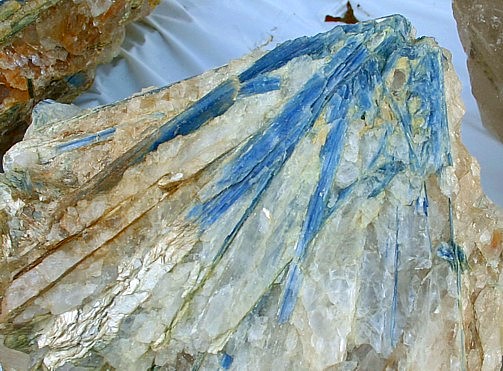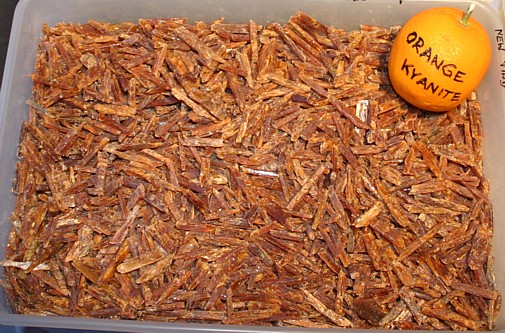
| KYANITE MINERAL FACTS |  |
|
| The Gem and Mineral Collector's Photo Gallery by Nevada Outback |
|
. Kyanite Mineral Facts:
Chemical Formula: Al2SiO5
Colors: blue or colorless, blue-green, rarely orange or black Hardness: 5 parallel to length of crystals, 7 at right angles to this direction. Density: 2.8 to 3 Cleavage: Perfect parallel to the pinacoids.
Crystallography: Triclinic - pinacoidal Luster:. Glassy, Vitreous to pearly luster (pearly on clevages). Optics: (Refractive Index): a = 1.7171, b=1.7222, y=1.7290. |
|
. |
Identification and Diagnostics A fragment moistened with cobalt nitrate and ignited assumes a blue color (test for aluminium). It is insoluble in acids. It is distinguished from the few other minerals that it resembles by the great differences in hardness on its cleavage surfaces. At a high temperature (about 1350) it apparently changes to sillimanite.
Occurrence,
Localities and Origins: Uses. Transparent kyanite is sometimes used as a semiprecious gemstone, which may display cat's eye chatoyancy, though this use is limited by its anisotropism and perfect cleavage. The cleavage makes it difficult to work as a gem, as the stone can break unexpectedly. Unusual gem color varieties include recently discovered orange kyanite from Tanzania. The orange color is due to inclusion of small amounts of manganese in the structure. Kyanite is primarily used industrially to enhance the refractory and strength characteristics of certain ceramic products, including porcelain plumbing fixtures and dishware. It is also used in electronics, electrical insulators and abrasives. Localities. A fine blue
material comes from Brazil, and a deep blue comes from Zaire. Crystals have been found at Greiner in the Tyrol; at Return to the Mineral Collectors Information Page |
|
|
 |
||
 |
|
|
|
|
|
|
Please note that the author, Chris Ralph, retains all copyrights to this entire document and it may not be reproduced, quoted or copied without permission.

NEVADA OUTBACK GEMS TURQUOISE AND JEWELRY